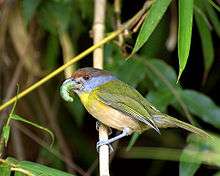Rufous-browed peppershrike
The rufous-browed peppershrike (Cyclarhis gujanensis) is a passerine bird in the vireo family. It is widespread and often common in woodland, forest edge, and cultivation with some tall trees from Mexico and Trinidad south to Argentina and Uruguay.
| Rufous-browed peppershrike | |
|---|---|
 | |
| C. g. ochrocephala feeding on a larva in São Paulo, Brazil | |
| Scientific classification | |
| Kingdom: | Animalia |
| Phylum: | Chordata |
| Class: | Aves |
| Order: | Passeriformes |
| Family: | Vireonidae |
| Genus: | Cyclarhis |
| Species: | C. gujanensis |
| Binomial name | |
| Cyclarhis gujanensis (Gmelin, 1789) | |
The adult rufous-browed peppershrike is approximately 15 cm (5.9 in) long and weighs 28 g (0.99 oz). It is bull-headed with a thick, somewhat shrike-like bill, which typically is blackish below and pinkish-grey above. The head is grey with a strong rufous eyebrow. The crown is often tinged with brown. The upperparts are green, and the yellow throat and breast shade into a white belly. The subspecies ochrocephala from the south-eastern part of its range has a shorter rufous eyebrow and a brown-tinged crown, while the subspecies virenticeps, contrerasi and saturata from north-western Peru and western Ecuador have greenish-yellow (not grey, as in the "typical" subspecies) nape, auriculars and cheeks.
The song is a whistled phrase with the rhythm "Do you wash every week?", but there are extensive variations depending on both individual and range. It is often heard but hard to see as it feeds on insects and spiders high in the foliage, though it has been observed to take small lizards as well.[2]
The nest is a flimsy cup high in a tree with a typical clutch of two or three pinkish-white eggs lightly blotched with brown. Like most vireos, the peppershrike ejects parasitic cowbird eggs.
Image gallery
- A bird on its nest, 10 m above a stream near El Copey de Dota, Costa Rica, illustrating how cryptic the nests can be.
 Illustration of C. g. contrerasi
Illustration of C. g. contrerasi
References
- BirdLife International (2012). "Cyclarhis gujanensis". IUCN Red List of Threatened Species. 2012. Retrieved 26 November 2013.CS1 maint: ref=harv (link)
- Delgado-V., Carlos A.; Brooks, Daniel M. (2003). "Unusual vertebrate prey taken by Neotropical birds" (PDF). Ornitología Colombiana. 1: 63–65.
- ffrench, Richard; O'Neill, John Patton; Eckelberry, Don R. (1991). A Guide to the Birds of Trinidad and Tobago (2nd ed.). Ithaca, N.Y.: Comstock Publishing. ISBN 0-8014-9792-2.
- Hilty, Steven L. (2003). Birds of Venezuela. Christopher Helm. ISBN 0-7136-6418-5.
External links
| Wikimedia Commons has media related to Cyclarhis gujanensis. |
| Wikispecies has information related to Cyclarhis gujanensis |
- BirdLife species factsheet for Cyclarhis gujanensis
- "Cyclarhis gujanensis". Avibase.

- "Rufous-browed peppershrike media". Internet Bird Collection.
- Rufous-browed peppershrike photo gallery at VIREO (Drexel University)
- Rufous-browed peppershrike species account at Neotropical Birds (Cornell Lab of Ornithology)
- Interactive range map of Cyclarhis gujanensis at IUCN Red List maps
- Audio recordings of Rufous-browed peppershrike on Xeno-canto.
- Cyclarhis gujanensis in the Flickr: Field Guide Birds of the World
